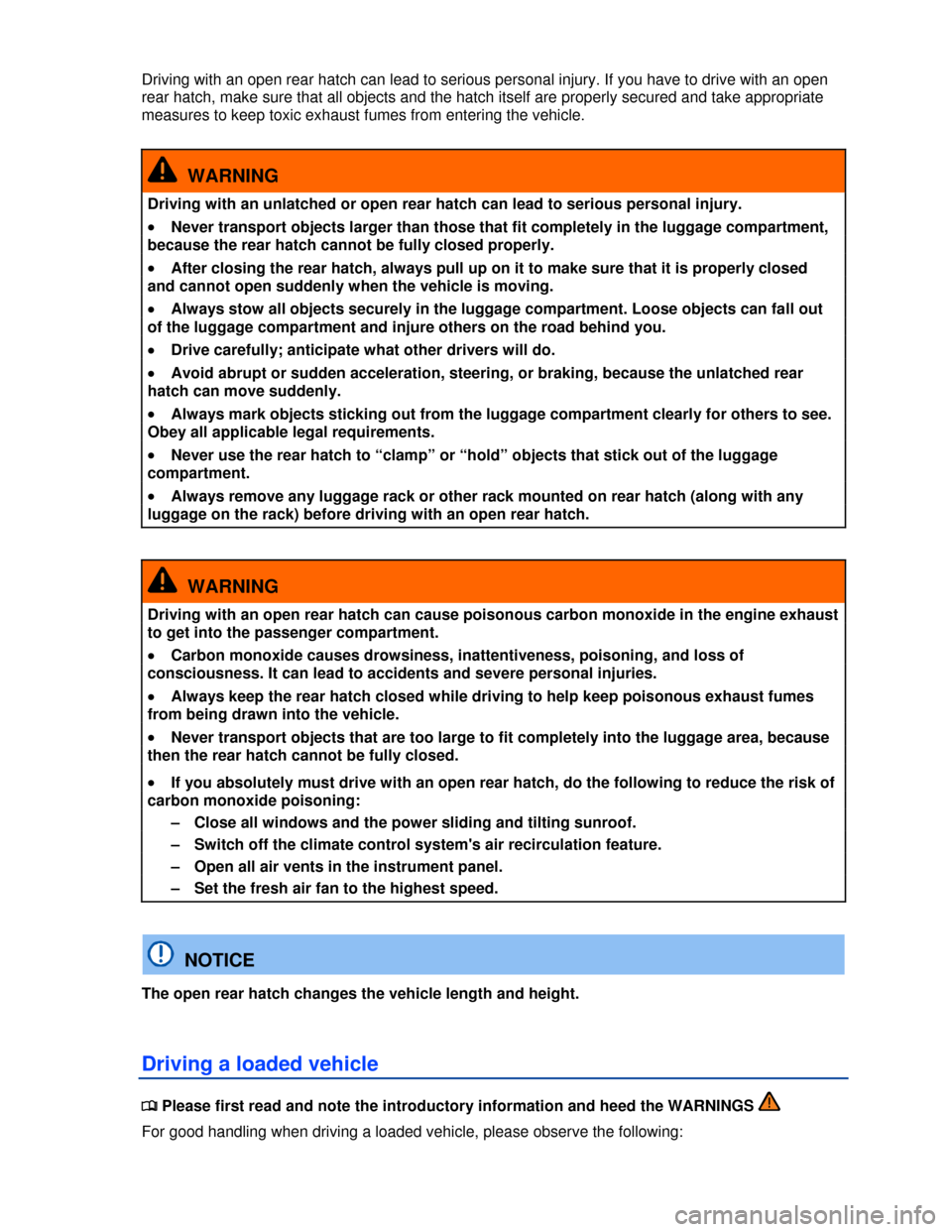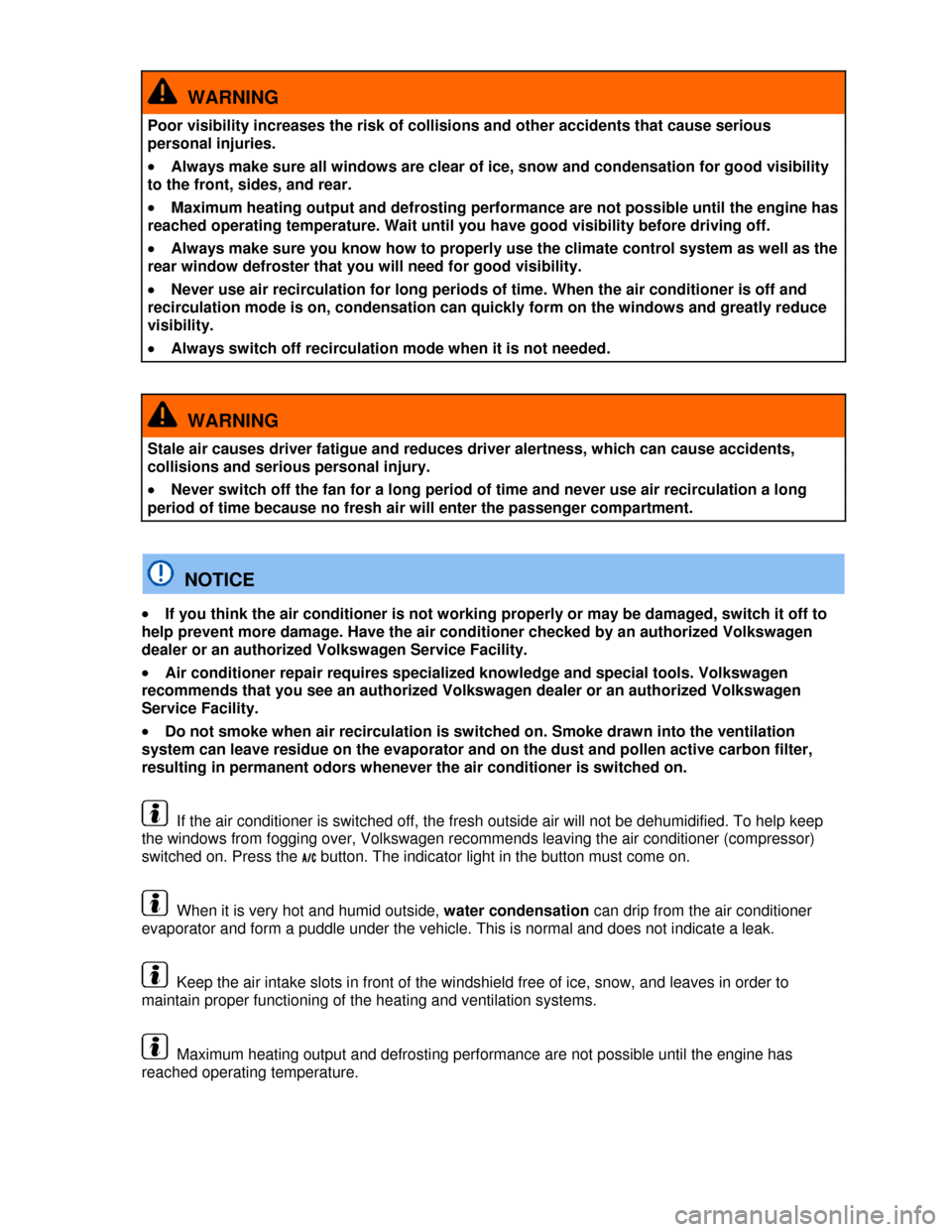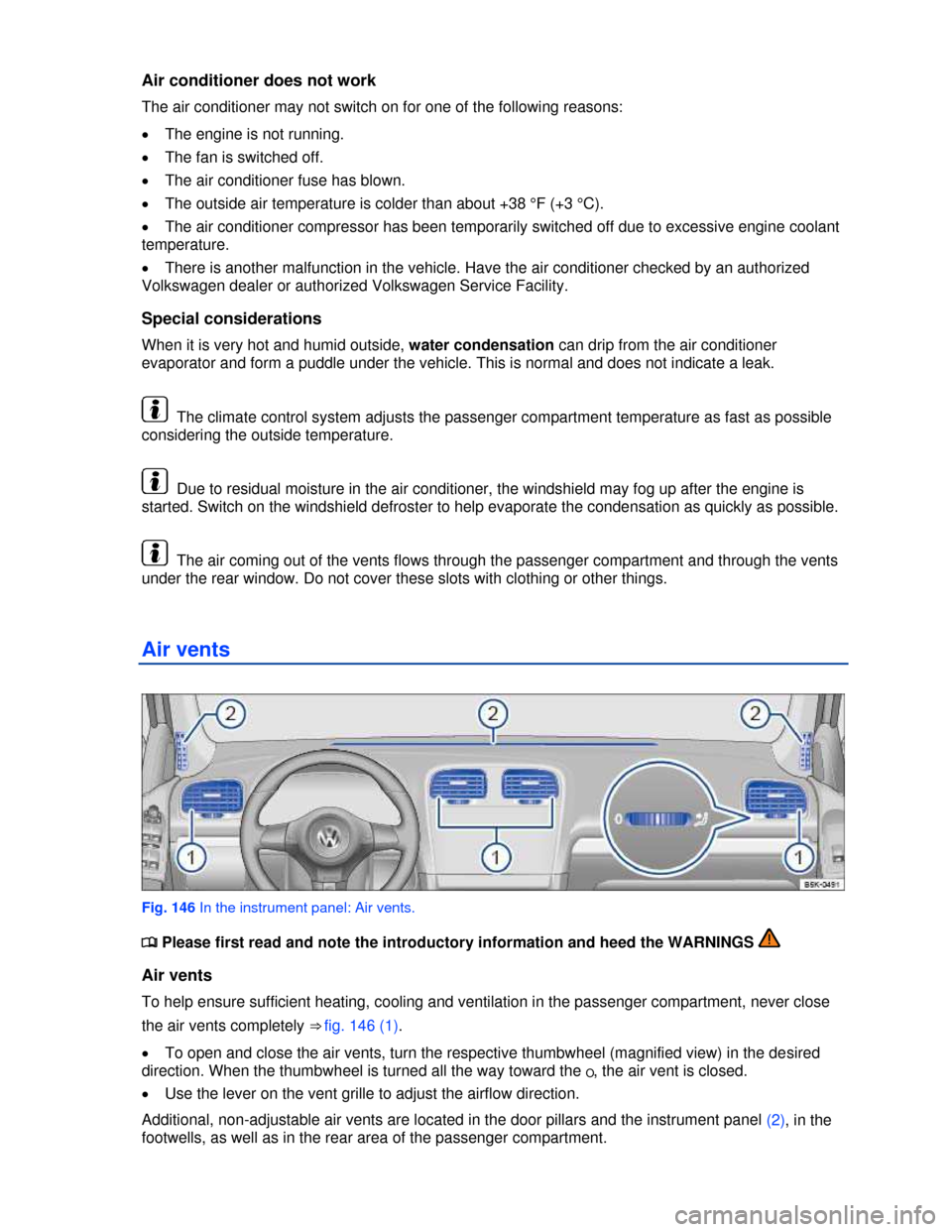2013 VOLKSWAGEN GOLF climate control
[x] Cancel search: climate controlPage 113 of 321

Driving with an open rear hatch can lead to serious personal injury. If you have to drive with an open
rear hatch, make sure that all objects and the hatch itself are properly secured and take appropriate
measures to keep toxic exhaust fumes from entering the vehicle.
WARNING
Driving with an unlatched or open rear hatch can lead to serious personal injury.
�x Never transport objects larger than those that fit completely in the luggage compartment,
because the rear hatch cannot be fully closed properly.
�x After closing the rear hatch, always pull up on it to make sure that it is properly closed
and cannot open suddenly when the vehicle is moving.
�x Always stow all objects securely in the luggage compartment. Loose objects can fall out
of the luggage compartment and injure others on the road behind you.
�x Drive carefully; anticipate what other drivers will do.
�x Avoid abrupt or sudden acceleration, steering, or braking, because the unlatched rear
hatch can move suddenly.
�x Always mark objects sticking out from the luggage compartment clearly for others to see.
Obey all applicable legal requirements.
�x Never use the rear hatch to “clamp” or “hold” objects that stick out of the luggage
compartment.
�x Always remove any luggage rack or other rack mounted on rear hatch (along with any
luggage on the rack) before driving with an open rear hatch.
WARNING
Driving with an open rear hatch can cause poisonous carbon monoxide in the engine exhaust
to get into the passenger compartment.
�x Carbon monoxide causes drowsiness, inattentiveness, poisoning, and loss of
consciousness. It can lead to accidents and severe personal injuries.
�x Always keep the rear hatch closed while driving to help keep poisonous exhaust fumes
from being drawn into the vehicle.
�x Never transport objects that are too large to fit completely into the luggage area, because
then the rear hatch cannot be fully closed.
�x If you absolutely must drive with an open rear hatch, do the following to reduce the risk of
carbon monoxide poisoning:
– Close all windows and the power sliding and tilting sunroof.
– Switch off the climate control system's air recirculation feature.
– Open all air vents in the instrument panel.
– Set the fresh air fan to the highest speed.
NOTICE
The open rear hatch changes the vehicle length and height.
Driving a loaded vehicle
�
Page 189 of 321

speed fluctuations caused by taking your foot off the accelerator. Active braking and accelerating is
then not necessarily required.
Calm and smooth driving
Consistency is more important than speed. The more smoothly you drive, the less fuel the vehicle
consumes.
When driving on the highway or freeway, a constant, moderate speed is more efficient and economical
than constantly accelerating and braking. Usually you can reach your destination just as quickly by
driving at a moderate, but steady speed.
The cruise control system can assist in maintaining a uniform driving style.
Moderate use of extra electrical loads
Comfort inside the vehicle is nice and important, but it is important to use them in an environmentally
conscious manner.
Some devices can increase fuel consumption when activated (examples):
�x Climate control system (air conditioner): If the air conditioner has to produce starkly contrasting
temperatures, it requires a large amount of energy, which is generated by the engine. The temperature
in the vehicle should therefore not be extremely different from that of the outside temperature. It may
be helpful to ventilate the vehicle before driving and then to drive a short distance with the windows
open. After that, switch on the air conditioner with the windows closed. Keep the windows closed when
driving at high speeds. Open windows increase fuel consumption.
�x Switch off seat heating once it has served its purpose.
�x Switch off the rear window defroster as soon as the windows are free of fog and ice.
Additional factors that increase fuel consumption (examples):
�x Malfunctioning engine control.
�x Driving in the mountains.
�x Towing a trailer.
NOTICE
Never let the vehicle coast or roll down a hill in Neutral (N), especially when the engine is not
running. The transmission will not be lubricated and will be damaged.
Page 207 of 321

WARNING
Poor visibility increases the risk of collisions and other accidents that cause serious
personal injuries.
�x Always make sure all windows are clear of ice, snow and condensation for good visibility
to the front, sides, and rear.
�x Maximum heating output and defrosting performance are not possible until the engine has
reached operating temperature. Wait until you have good visibility before driving off.
�x Always make sure you know how to properly use the climate control system as well as the
rear window defroster that you will need for good visibility.
�x Never use air recirculation for long periods of time. When the air conditioner is off and
recirculation mode is on, condensation can quickly form on the windows and greatly reduce
visibility.
�x Always switch off recirculation mode when it is not needed.
WARNING
Stale air causes driver fatigue and reduces driver alertness, which can cause accidents,
collisions and serious personal injury.
�x Never switch off the fan for a long period of time and never use air recirculation a long
period of time because no fresh air will enter the passenger compartment.
NOTICE
�x If you think the air conditioner is not working properly or may be damaged, switch it off to
help prevent more damage. Have the air conditioner checked by an authorized Volkswagen
dealer or an authorized Volkswagen Service Facility.
�x Air conditioner repair requires specialized knowledge and special tools. Volkswagen
recommends that you see an authorized Volkswagen dealer or an authorized Volkswagen
Service Facility.
�x Do not smoke when air recirculation is switched on. Smoke drawn into the ventilation
system can leave residue on the evaporator and on the dust and pollen active carbon filter,
resulting in permanent odors whenever the air conditioner is switched on.
If the air conditioner is switched off, the fresh outside air will not be dehumidified. To help keep
the windows from fogging over, Volkswagen recommends leaving the air conditioner (compressor)
switched on. Press the �!�
Page 213 of 321

Air conditioner does not work
The air conditioner may not switch on for one of the following reasons:
�x The engine is not running.
�x The fan is switched off.
�x The air conditioner fuse has blown.
�x The outside air temperature is colder than about +38 °F (+3 °C).
�x The air conditioner compressor has been temporarily switched off due to excessive engine coolant
temperature.
�x There is another malfunction in the vehicle. Have the air conditioner checked by an authorized
Volkswagen dealer or authorized Volkswagen Service Facility.
Special considerations
When it is very hot and humid outside, water condensation can drip from the air conditioner
evaporator and form a puddle under the vehicle. This is normal and does not indicate a leak.
The climate control system adjusts the passenger compartment temperature as fast as possible
considering the outside temperature.
Due to residual moisture in the air conditioner, the windshield may fog up after the engine is
started. Switch on the windshield defroster to help evaporate the condensation as quickly as possible.
The air coming out of the vents flows through the passenger compartment and through the vents
under the rear window. Do not cover these slots with clothing or other things.
Air vents
Fig. 146 In the instrument panel: Air vents.
�